Home > Digitized Walters Manuscripts
This document is a tranformation of a TEI P5 XML manuscript description incorporating images. If you have trouble reading special or non-Latin characters on this page, please make sure you have appropriate Unicode fonts installed and an up-to-date web browser.
Walters Ms. W.18, Rochester New Testament
Browse images (Browse images in a new window) | TEI in XML format
W.18
Rochester New Testament
This large-format copy of the New Testament was almost certainly created at Rochester Cathedral Priory, England, in the first half of the twelfth century. It was part of a five-volume Bible, only one other volume of which, London, British Library Ms. Royal I.C.VII, has survived. The decorated initials in these manuscripts compare closely with those in other books securely attributed to Rochester. Textually these books are closely related to the Gundulph Bible (San Marino, Huntington Library Ms. HM 62), known to have been produced at Rochester in the second half of the eleventh century. Although neither the Walters' nor the British Library's volume includes an inscription associating this Bible with Rochester, the two medieval catalogs of the Rochester Cathedral library, produced around 1130 and in 1202, contain references to manuscripts that correspond well with them. The book’s large size indicates it that was designed to be read aloud, either during services or at meals in the refectory. Large, fanciful initials filled with succulent foliage, fruit, dragons, animals, and human faces begin each section of the text. Executed in a vibrant palette of red, blue, green, ochre (in place of gold), and yellow, the intricate, dynamic designs capture the essence of Romanesque manuscript illumination. Royal I.C.VII also includes four historiated initials (for the books of Joshua, I Samuel, 2 Samuel, and 2 Kings). Although the Bible was made at Rochester, the pre-Gothic script of W.18 in particular is extremely close to that practiced at nearby Canterbury at the time.
Ca. 1130 CE
Rochester, England
Book
Scriptural
The primary language in this manuscript is Latin.
Parchment
Cream-colored parchment of medium thickness, well surfaced, with water and mold damage to lower corners
Foliation: ii+248+ii
Earlier foliation in light pencil in uppermost corners; darker modern pencil foliation below (followed here)
Formula: ii, 1(8,-3,4,5,6), 2-6(8), 7(8,-4), 8-23(8), 24(8,-8), 25-31(8), 32(2), 33(4), ii
Catchwords: None
Signatures: Usually uppercase roman numerals in lower margin of versos of the last folio of the quire and occasionally in lower margin of rectos of the first folio of the quire; last three quires have arabic numerals in lower margin of rectos of the first folio of the quire; first extant quire has the quire signature II
Comments: Quires begin on fols. 1(1), 5(2), 13(3), 21(4), 29(5), 37(6), 45(7), 52(8), 60(9), 68(10), 76(11), 84(12), 92(13), 100(14), 108(15), 116(16), 124(17), 132(18), 140(19), 148(20), 156(21), 164(22), 172(23), 180(24), 187(25), 195(26), 203(27), 211(28), 219(29), 227(30), 235(31), 243(32), and 245(33); manuscript missing its first quire; two folios missing between fols. 4 and 5; folio missing between fols. 47 and 48 ; folio missing between fols. 186 and 187; 32nd quire consists of two singletons that were the first two folios of the present quire 33 before the present binding; text of manuscript complete at the end; conjoints of the two leaves in the 32nd quire would have been blank
28.3 cm wide by 38.5 cm high
18.2 cm wide by 28.3 cm high
- Columns: 2
- Ruled lines: 30
- Ruled in hard point some folios, brown ink others; double vertical and horizontal bounding lines, frequently extending to edges of folios; above top line
- Title: New Testament
- Rubric: Incipit evangelium secundum Matheum
- Incipit: Liber generationis
- Contents: Incomplete: Fols. 1r-28v: Gospel of Matthew [Missing 3:2-7:24]; fols. 29r-47v: Gospel of Mark to Chapter 16:8 (dixerunt time...); [missing Mark 16:8-Luke 1:15; fols. 48r-80v: Gospel of Luke from 1:15 (enim magnus coram domino); fols. 81r-105v: Gospel of John; fol. 106r: Incipit argumentum Actuum Apostolorum (Actus Apostolorum nudam [Stegmüller 631]), Incipit praefatio sancti Ieronimi presbiteri in Actus Apostolorum (Lucas natione syrus [Stegmüller 640]); fols. 106v-107v: Capitula (Ubi praecepit dominus); fols. 107v-141r: Acts of the Apostles; fols. 141r-v: Incipit prologus Epistolarum Apostolorum (Non ita est ordo [Stegmüller 809]); fols. 141v-142r: Incipiunt capitula in Epistola beati Iacobi Apostoli (De inimicorum); fol. 142r: Incipit argumentum (Iacobus Apostolus [Stegmüller 806]); fols.142r-145v: James; fol. 145v: Incipiunt capitula in Epistola prima beati Petri Apostoli (De regenerationis), Incipit argumentum (Discipulos salvatoris invictos [Stegmüller 812]); fols. 146r-107v: I Peter; fol. 149v: Incipiunt capitula Epistolae secundae eiusdem (De sanctis quos), Incipit argumentum (Per fidem huic mundo [Stegmüller 817]); fols. 149v-152r: II Peter; fol. 152r: Incipiunt capitula Epistolae beati Johannis Apostoli primae (De verbo vitae); fols. 152r-155v: I John; fol. 155v: Incipiunt capitula Epistolae secundae eiusdem (De diligendis), Incipit argumentum (Usque adeo [Stegmüller 823]); fols. 155v-156r: II John; fol. 156r: Incipiunt capitula Epistolae tertiae (De filiis Apostoli); fols. 156r-v: Incipit argumentum (Gaium pietatis causa [Stegmüller 824]); fols. 156v-157r: III John; fol. 157r: Incipiunt capitula Epistolae beati Judae Apostoli (De falsis doctoribus); fols. 157r-158r: Jude; fols. 158r-v: Incipit argumentum Epistolarum Pauli Apostoli (Epistolae Pauli ad Romanos causa [Stegmüller 651]); fols. 158v-160r: Incipit praefatio epistolarum pauli apostoli (Primun quaeritur [Stegmüller 670]); fols. 160r-161r: Item argumentum (Romani qui ex iudeis [Stegmüller 674]); fol. 161r: Argumentum (Romani sunt in partibus italiae ... Iam dudum saulus [Stegmüller 677, 654]); fols. 161r-v: Incipiunt capitula (De nativitate christi secundum carnem); fols. 161v-174r: Romans; fols. 174r-175r: Incipit argumentum Epistolae ad Corinthios (Chorinthii sunt [Stegmüller 684]), Item argumentum (Chorinthus metropolis civitas [Stegmüller 689]); fol. 175r: Incipiunt capitula Epistolae ad Corinthios (Obsecro itaque); fols. 175r-186v: I Corinthians to 16.10 (si autem venerit timothe...); [missing Corinthians 16.10 - II Corintihians 1:9]; fols. 187r-194v: II Corinthians, from 1:9 (qui suscitat mortuos); fol. 194v: Incipit argumentum Epistolae ad Galathas (Galathae sunt Greci [Stegmüller 707]), Incipiunt capitula (Miror quod sic); fols. 195r-198v: Galatians; fol. 199r: Incipit argumentum Epistolae ad Ephesios (Ephisii sunt [Stegmüller 715]), Incipiunt capitula (Benedictus deus); fols. 199r-203r: Ephesians; fol. 203r: Incipit argumentum Epistolae ad Phylippenses (Phylippenses sunt Macedones [Stegmüller 728]), Incipiunt capitula (Gratias ago); fols. 203r-206r: Philippians; fol. 206r: Incipit argumentum Epistolae ad Colosenses (Colosenses et hi sicut [Stegmüller 736]), Incipiunt capitula (Gratias agimus deo); fols. 206v-209r: Colossians; fol. 209r: Incipit argumentum Epistolae ad Thessalonicenses (Thessalonicenses sunt Macedones [Stegmüller 747]), Incipiunt capitula (Gratias agimus deo); fols. 209r-211v: I Thessalonians; fol. 211v: Incipit argumentum Epistolae secundae ad Eosdem (Ad Thassalonicenses secundum scribit [Stegmüller 752]), Incipiunt capitula (Gratias agere); fols. 212r-213r: II Thessalonians; fol. 213r: Incipit argumentum Epistolae ad Timotheum (Timotheum instruit [Stegmüller 765]), Incipiunt capitula (Sicut rogavi); fols. 213r-216v: I Timothy; fol. 216v: Incipit argumentum Epistolae secundae ad Eundem (Item Timotheo [Stegmüller 772]), Incipiunt capitula (Noli itaque); fols. 216v-218v: II Timothy; fols. 218v-219r: Incipit argumentum Epistolae ad Titum (Titum commone fecit [Stegmüller 780]); fol. 219r: Incipiunt capitula (Huius rei gratia); fols. 219r-220r: Titus; fol. 220r: Incipit argumentum Epistolae ad Phylemonem (Phylemoni familiares [Stegmüller 783]), Incipiunt capitula (Gratias ago deo); fols. 220v-221r: Philemon; fol. 221r: Incipit argumentum Epistolae ad Hebreos (In primis dicendum est [Stegmüller 794]), Incipiunt capitula (Multifariae multisque); fols. 221v-230v: Hebrews; fols. 230v-231r: Incipiunt capitula in Epistola ad Laodicenses; fols. 231r-v: (Paulus Apostolus pro Laodicensibus), Laodicensians; fols. 231v-232r: Incipit prologus beati Ieronimi presbiteri in Apocalypsi (Johannes Apostolus et Evangelista [Stegmüller 835]); fol. 232r: Incipiunt capitula (Johannes septem ecclesiis); fols. 232v-248r: Apocalypse
- Text note: Prefatory materials and texts extremely similar to the Gundulf Bible (San Marino, Huntington Library Ms. HM 62), made at Rochester in the second half of the eleventh century. The missing first quire probably contained prefaces to Gospels (Epistle of Jerome to Damasus, Novum opus; Prologue of Jerome, Plures fuisse; possibly letter of Eusebius to Carpianus, Ammonium quidem; and possibly spurious addition to Jerome's Epistle to Damasus, Sciendem etiam)
- Hand note: Written in pre-Gothic bookhand, with a smaller version used for chapter lists; opening words of each book in majuscule display script; scribe writing in a script particularly associated with Christ Church Canterbury and houses under its influence in the early twelfth century; suggested by Richards that this volume was written by a Christ Church Canterbury scribe
- Decoration note: Twenty-six large, ornate initials (Luke's is missing, as is that for II Corinthians), decorated with heavy foliate designs inhabited by fanciful creatures and human faces (4 to 30 lines high); smaller undecorated initials throughout (1 to 8 lines high); incipits in square capitals written in alternating lines of blue, green, red, and yellow; text in black ink. The initials in W.18 compare closely with the initials in two manuscripts of certain Rochester provenance. One of these, London, British Library Ms. Royal 5.D.III, containing the first volume of Augustine’s Enarationes in Psalmos, includes inhabited initials similar to those in W.18. The historiated initial showing a seated St. Ambrose in the second manuscript, London, British Library Ms. Royal 6.B.VI--a volume containing Ambrose’s De mysteriis and De sacramentis, Ivo of Chartres’s sermones and Epistolae, and Bruno of Asti’s De sacramentis ecclesiae--compares with the historiated initials in W.18's sister volume, London, British Library Ms. Royal I.C.VII. The script and decoration of W.18 and Royal 1.C.VII are related to styles of script and decoration developed at Canterbury.
fol. 1r:
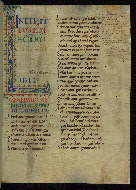
- Title: Initial "L" (Liber generationis)
- Form: Inhabited initial "L," 21 lines
- Text: Holy Gospel of Jesus Christ, according to St. Matthew
- Label: Four winged dragons fill the compartments of this initial "L," the sides of which are adorned with succulent green and blue profile foliage. Two confronted dragons in the lower part of the letterform bite a diminutive human head, as if battling over its possession. The "L" is topped by a human face, painted blue, from which emerge two intertwined, green bird-like dragons.
- Comment:
The inscription reads "capud primus," in a later hand.
It has been suggested (Richards, 1981) that the large space to the right of the initial "L" was intended to have been rendered as an historiated initial.
fol. 29r:
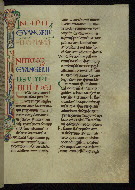
- Title: Initial "I" (Initium Evangelii)
- Form: Inhabited initial "I," 31 lines
- Text: Holy Gospel of Jesus Christ, according to St. Mark
- Label: Two confronted leonine or feline animals, viewed from above, and a profile winged dragon with a human face and foliate tail fill the shaft of this letter "I." The "I" is topped by red and green foliage and a frontal, bearded human face, which, although lacking a cross-halo, resembles depictions of Jesus in medieval art. The tail of the "T" includes a frontal, bearded devil-like face, painted blue and equipped with what appear to be horns. Perhaps the arrangement of figural and animal elements in this initial is meant to evoke the idea of spiritual struggle or the victory of Jesus, above, over the devil, below.
fol. 81r:
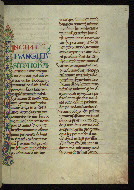
- Title: Initial "I" (In principio)
- Form: Inhabited initial "I," 33 lines
- Text: Holy Gospel of Jesus Christ, according to St. John
- Label: The shaft of this letter "I" is filled with delicately rendered palmettes. Green vine-scrolls ascend and weave in and out of the letterform, as if climbing a trellis. The letterform is topped by a frontal green animal face and two addorsed dragons, portrayed in profile.
fol. 107v:
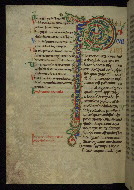
- Title: Initial "P" (Primum quidem)
- Form: Inhabited initial "P," 30 lines
- Text: Acts of the Apostles
- Label: Green vine-scrolls ascend and weave in and out of this letter "P," as if climbing a trellis. Two dragons roar at one another from within the upper part of the letterform.
fol. 142r:
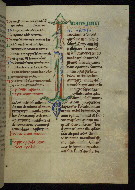
- Title: Initial "I" (Iacobus Dei)
- Form: Inhabited initial "I," 26 lines
- Text: Catholic Epistle of St. James the Apostle
- Label: A single winged dragon, its tail ending in fleshy profile leaves and a thick, leaf-crowned stem or stalk emanating from its open mouth, adorns the length of this letter "I."
fol. 146r:
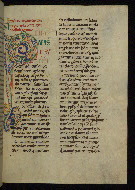
- Title: Initial "P" (Petrus Apostolus)
- Form: Inhabited initial "P," 25 lines
- Text: First Epistle of St. Peter the Apostle
- Label: The undulating bodies of two winged dragons with foliate tails form this letter "P." A profile, bearded, and mustached human face at the very end of the letter’s tail disgorges a fleshy stalk crowned with large profile leaves, from which emerge two further profile faces. These faces, clean-shaven and connected at the ears, open their mouths in order to eat small flowers or plants that grow from the tops of the leaves--as if devouring the very source of their existence.
fol. 149v:
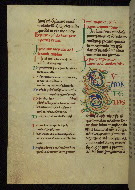
- Title: Initial "S" (Symon Petrus)
- Form: Inhabited initial "S," 11 lines
- Text: Second Epistle of St. Peter the Apostle
- Label: A dragon with heads at either end of its sinuous body forms this letter "S." From each head emerges a curling stem sprouting large profile leaves and terminating in a flower.
fol. 152r:
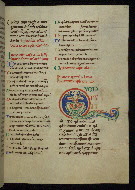
- Title: Initial "Q" (Quod fuit)
- Form: Inhabited initial "Q," 7 lines
- Text: First Epistle of St. John the Apostle
- Label: Seated within the letter "Q" is a curious creature with a human body and two dog heads, joined at the ear and growing from a single neck. Wearing a short tunic cinched at the waist and holding a leafy stalk in either hand, this hybrid creature rests its feet on the long ears of a sinuous, amber-eyed dragon, which stares out at the viewer, its body forming the tail of the "Q."
fol. 155v:
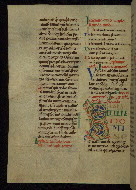
- Title: Initial "S" (Senior electe)
- Form: Decorated initial "S," 10 lines
- Text: Second Epistle of St. John the Apostle
- Label: Vines or stalks sprouting succulent foliage form this letter "S."
fol. 156v:
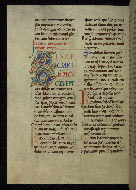
- Title: Initial "S" (Senior Gaio)
- Form: Inhabited initial "S," 8 lines
- Text: Third Epistle of St. John the Apostle
- Label: A sinuous dragon disgorging a leafy, flowering stalk, its tail terminating in another leafy vine, forms this letter "S."
fol. 157r:
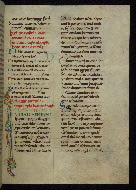
- Title: Initial "I" (Iudas Iesu Christi)
- Form: Inhabited initial "I," 21 lines
- Text: Catholic Epistle of St. Jude the Apostle
- Label: A single dragon, a leafy stem emanating from its open mouth, another forming its long tail, adorns the length of this initial "I."
fol. 161v:
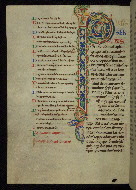
- Title: Initial "P" (Paulus servus)
- Form: Inhabited initial "P," 31 lines
- Text: Epistle of St. Paul the Apostle to the Romans
- Label: The shaft of this letter "P" is filled with delicately rendered palmettes growing from green vine-scrolls that ascend and weave in and out of the letterform, as if climbing a trellis. A blue dragon’s head occurs in the upper part of the letterform; the tail of the "P" terminates in a profile head with blue hair, mustache, and beard.
fol. 175r:
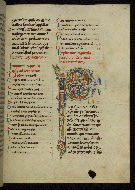
- Title: Initial "P" (Paulus vocatus)
- Form: Inhabited initial "P," 21 lines
- Text: First Epistle of St. Paul to the Corinthians
- Label: Three dragons--their tails terminating in winding foliage, one at the top of the letterform disgorging a curling vine terminating in succulent leaves--form this initial "P."
fol. 195r:

- Title: Initial "P" (Paulus Apostolus)
- Form: Inhabited initial "P," 23 lines
- Text: Epistle of St. Paul to the Galatians
- Label: Green vine-scrolls sprouting succulent foliage ascend and weave in and out of the shaft of this letter "P," as if climbing a trellis. Two winged dragons disgorge further vines in the upper part of the letterform.
fol. 199r:
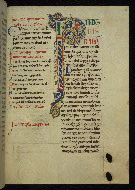
- Title: Initial "P" (Paulus Apostolus)
- Form: Inhabited initial "P," 23 lines
- Text: Epistle of St. Paul to the Ephesians
- Label: Long, slender leaves fill the shaft of this letter "P." A dragon head at the top of the letter bites or disgorges the upper, curved part of the letter, which is filled with a curling vine-scroll sprouting succulent foliage.
fol. 203r:
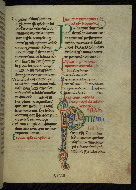
- Title: Initial "P" (Paulus et)
- Form: Inhabited initial "P," 17 lines
- Text: Epistle of St. Paul to the Philippians
- Label: Bold zigzag designs fill the shaft of this letter "P." A winged dragon disgorging succulent foliage forms the upper part of the letterform.
fol. 206v:
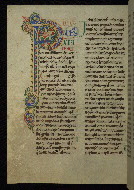
- Title: Initial "P" (Paulus Apostolus)
- Form: Inhabited initial "P," 27 lines
- Text: Epistle of St. Paul to the Colossians
- Label: Abstract palmettes adorn the shaft of this letter "P." The upper part of the letterform includes a blue dragon’s head and is filled with a large bloom emerging from succulent green leaves.
fol. 209r:
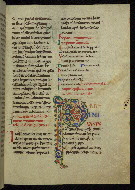
- Title: Initial "P" (Paulus et)
- Form: Inhabited initial "P," 17 lines
- Text: First Epistle of St. Paul to the Thessalonians
- Label: Two confronted, winged dragons bite a green ball or a bit of foliage in the upper part of this letterform, as if battling over its possession. Succulent foliage adorns the rest of the letter "P."
fol. 212r:
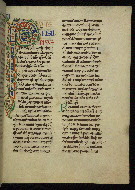
- Title: Initial "P" (Paulus et)
- Form: Inhabited initial "P," 23 lines
- Text: Second Epistle of St. Paul to the Thessalonians
- Label: The vine-scrolls adorning this letter "P" spiral so hypnotically, one might overlook the blue dragon’s head in the upper part of the letterform and the profile human face emerging from a leaf at the tip of the letter’s tail.
fol. 213v:
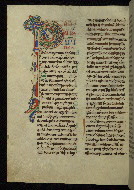
- Title: Initial "P" (Paulus Apostolus)
- Form: Inhabited initial "P," 24 lines
- Text: First Epistle of St. Paul to Timothy
- Label: Two confronted leonine animals with elongated necks straddle the frame of the shaft of this letter "P," biting their own forepaws. Another animal is entangled in the spiraling foliage that fills the upper part of the letterform.
fol. 216v:
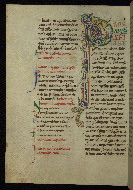
- Title: Initial "P" (Paulus Apostolus)
- Form: Inhabited initial "P," 25 lines
- Text: Second Epistle of St. Paul to Timothy
- Label: Two confronted winged dragons stare menacingly at one another within the shaft of this letter "P." A third, larger dragon with multicolor wings occurs in the upper part of the letter. From its mouth emanates a curling foliate vine-scroll.
fol. 219r:
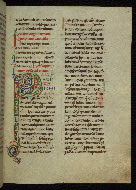
- Title: Initial "P" (Paulus servus)
- Form: Decorated initial "P," 21 lines
- Text: Epistle of St. Paul to Titus
- Label: Abstract designs and spiraling vine-scrolls adorn this letter "P."
fol. 220v:
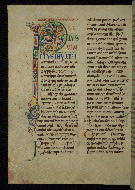
- Title: Initial "P" (Paulus vinctus)
- Form: Inhabited initial "P," 25 lines
- Text: Epistle of St. Paul to Philemon
- Label: Abstract designs in compartments adorn the shaft of this letter "P." Two profile dragon’s heads emerge from the top of the shaft, so that this part of the letter resembles the capital of a Romanesque column. The dragon on the right bites or disgorges a spiraling vine-scroll, one of the tendrils of which terminates in a profile human head.
fol. 221v:
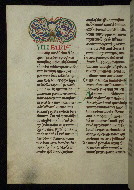
- Title: Initial "M" (Multifarie multisque)
- Form: Inhabited initial "M," 6 lines
- Text: Epistle of St. Paul to the Hebrews
- Label: A frontal human face adorns the place where the two halves of this letter "M" are joined. The rest of the letterform is adorned with spiraling vine-scrolls sprouting succulent foliage.
fol. 231r:
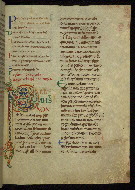
- Title: Initial "P" (Paulus Apostolus)
- Form: Inhabited initial "P," 21 lines
- Text: Epistle of St. Paul to the Laodiceans
- Label: A zigzag design fills the shaft of this letter "P." The upper part of the letterform includes a single winged dragon, which bites or disgorges a spiraling vine-scroll sprouting succulent foliage.
fol. 232v:

- Title: Initial "A" (Apocalypsis Iesu Christi)
- Form: Inhabited initial "A," 19 lines
- Text: Apocalypse of St. John the Apostle (book of Revelation)
- Label: Two dragons with foliate tails and multicolored wings form the sloping sides of this letter "A." One of the creatures bends its neck to bite its own paw; the other raises its grinning face to gaze beyond the boundary of the page. The letterform is filled with spiraling vine-scrolls sprouting succulent foliage. From one of these leaves emerges a diminutive profile human face.
The binding is not original.
New binding made of alum-processed pigskin and quarter-sawn oak boards by Abigail Quandt, Walters Art Museum, Baltimore, 1986; previous binding probably by Leon Gruel, early 20th century, constructed of five recessed cords laced into heavy millboards covered in red silk; manuscript rebound two or three times since the twelfth century
Priory scriptorium of Rochester Cathedral, England, twelfth century (possible reference in catalog in Textus Roffensis, Rochester Cathedral Library Ms. A.3.5, fol. 230r; more certain reference in 1202 library catalog in British Library Ms. Royal 5 B.XII, fol. 2r)
Leon Gruel collection, no. 1138, Paris, before 1931
Henry Walters, Baltimore, acquired from Gruel, before 1931
Walters Art Museum, 1931, by Henry Walters bequest
De Ricci, Seymour. Census of Medieval and Renaissance Manuscripts in the United States and Canada. Vol. 1. New York: H. W. Wilson Company, 1935, p. 766, no. 57.
Walters Art Gallery. Illuminated Books of the Middle Ages and Renaissance: An Exhibition Held at the Baltimore Museum of Art. Baltimore: Trustees of the Walters Art Gallery, 1949, no. 19, pl. XIII.
Dodwell, C. R. The Canterbury School of Illumination, 1066-1200. Cambridge: Cambridge University Press, 1954, pp. 65, 74, 119, fig. 37g (fol. 146).
Boase, T. S. R. English Art 1100-1216. Oxford: Clarendon Press, 1959, pp. 63-65, 160, fig. 19b.
Walters Art Gallery. 2,000 Years of Calligraphy. Totowa, NJ: Rowman and Littlefield, 1965, no. 22.
Berkowitz, David S. In Remembrance of Creation: Evolution of Art and Scholarship in the Medieval and Renaissance Bible. Waltham, MA: Brandeis University Press, 1968, no. 65.
Alexander, J. J. G., and C. M. Kauffmann. English Illuminated Manuscripts 700-1500. Brussels: Bibliotheque Royale Albert, 1973, pp. 52-53, no. 26, pl. II.
Kauffmann, C. M. Romanesque Manuscripts 1066-1190. Vol. 3. London: Harvey Miller, 1975, no. 45, figs. 123-126.
Richards, Mary P. "A Decorated Vulgate Set from a 12th Century Illuminated Manuscript on Vellum." Journal of the Walters Art Gallery 39 (1981): 59-67, figs. 1, 2, 6.
Quandt, Abigail B. 1986. American Institute for Conservation of Historic and Artistic Works, preprint of a paper presented at the fourteenth annual meeting, Chicago, May 21-25, 1986 (The Conservation of a Twelfth Century Illuminated Manuscript on Vellum) 97-113.
Burin, Elizabeth. "Mixing Styles on the Pilgrimage Roads: A Romanesque Manuscript in the Walters Art Gallery." Journal of the Walters Art Gallery 54 (1996): 9-20, fig. 16 (fol. 1r).
Noel, William, and Daniel Weiss. The Book of Kings: Art, War, and the Morgan Library's Medieval Picture Bible. London: Third Millennium Publishing; Baltimore: Walters Art Museum, 2002, p. 150, no. 1 (fol. 161v).
Principal catalogers: Herbert, Lynley; Noel, William; Smith, Kathryn
Cataloger: Walters Art Museum curatorial staff and researchers since 1934
Editors: Herbert, Lynley; Noel, William
Copy editor: Bockrath, Diane
Conservators: Owen, Linda; Quandt, Abigail
Contributors: Bockrath, Diane; Dutschke, Consuelo; Emery, Doug; Grollemond, Larisa; Noel, William; Tabritha, Ariel; Toth, Michael B.
The Walters Art Museum
Licensed for use under Creative Commons Attribution-NonCommercial-ShareAlike 3.0 Unported Access Rights, http://creativecommons.org/licenses/by-nc-sa/3.0/legalcode. It is requested that copies of any published articles based on the information in this data set be sent to the curator of manuscripts, The Walters Art Museum, 600 North Charles Street, Baltimore MD 21201.